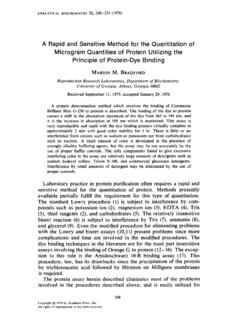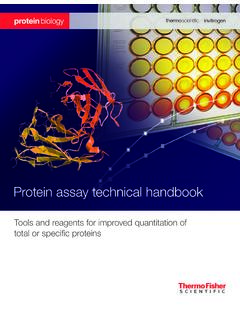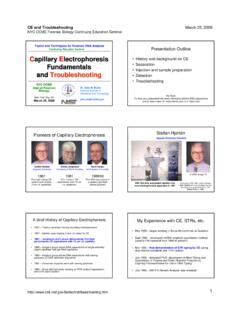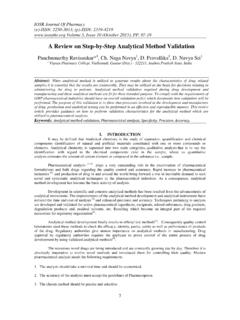Transcription of Guide to the Homogenization of Biological Samples
1 Random Primers, Issue No. 7, Sept. 2008, Page 1-14 Guide to the Homogenization of Biological Samples A 2012 update of this Guide can be found by clicking this link. David W. Burden, Abstract Many tools are available for the Homogenization of Samples . These homogenizers can be generally grouped into those that grind, shear, beat, and shock, though many disruption processes rely on more than one type of force. When developing a disruption scheme, it is critical to define the characteristics of the homogenate and then select the tools that will help to meet the objectives. The examination of methods used to homogenize Samples has shown that effectiveness is directly related to the nature of the sample. Samples that start with small particles, such as bacterial cultures, are most effectively disrupted by ultrasonication, but that same method is the poorest for solid muscle.
2 In such cases, Samples must be first disaggregated into smaller particles prior to processing. methods which rely on a single processing step, such as with the high throughput homogenizers, can yield very good sample disruption, but they do not match two-step processes that breakdown Samples in a series of steps. The need to process large numbers of Samples requires a trade-off with level of effective Homogenization . Table of Contents Introduction .. 2 Strategies for Homogenization : Selecting a Method(s) .. 2 Harvesting Samples .. 3 Examination of methods .. 3 Grinding .. 4 Mortar & Pestle .. 4 Cryogenic Grinding with Mortar & Pestle .. 4 CryoGrinder for Small Sample Grinding .. 5 Tissues Disruption with Glass Homogenizers .. 5 Vortexer Bead Beating .. 7 Shearing .. 7 Blender .. 7 Rotor-Stator .. 7 Dounce Homogenizer .. 8 Potter-Elvehjem with PTFE Pestle.
3 8 French Press or French Pressure Cell .. 8 Beating .. 9 Amalgamators for Tubes .. 9 High Throughput Homogenizers .. 9 Shock .. 11 Sonication .. 11 Combined methods .. 11 Comparing the methods .. 12 Summary .. 13 Materials and methods .. 14 Microorganisms .. 14 Tissue Samples .. 14 Cell Culture .. 14 Lactate Dehydrogenase Assay .. 14 OPS Diagnostics, LLC, Box 348, Lebanon, NJ 08833 TEL (908) 253-3444 Email: 2 IntroductionThe disruption of Samples is an early step in the process of isolation and/or quantifying RNA, DNA, proteins, and analytes. Both chemical and mechanical/physical methods are available for disruption, with chemical methods being preferred for many sample types ( , E.)
4 Coli and cultured cells). However, many microorganisms, intact tissues, solid specimens, such as seeds, and heavily encased Samples are not efficiently disrupted chemically. With such resilient Samples mechanical and physical methods that rely on grinding, shearing, beating and shocking are used. Mechanical homogenizers, manual homogenizers, mortar and pestles, sonicators, mixer mills, and vortexers are several of the more common tools used for mechanical and physical disruption. Sample disruption, or Homogenization , is not the most exciting methodology to examine, but none-the-less it does have significant impact on the end results of a process. Though used daily and extensively, methods for sample disruption are not necessarily well understood. Indeed like many well established lab processes, the methods are passed on from researcher to researcher like inheritable family treasures, with little effort expended to decipher the process itself.
5 Being fair, the impact of Homogenization on an experiment may be minimal, but at times the choice of tool and its method of use may have a significant impact on the outcome. Where possible, chemical means may be the preferred method, such as with the lysis of E. coli with SDS for plasmid isolation, but it may also introduce unwanted molecules into the lysate. Though useful for nucleic acid isolation, detergents and chaotropes may certainly denature proteins which can make their use undesirable in protein purification schemes. The same is true for the addition of lytic enzymes, which in the case of protein purification, must be subsequently removed. If adding chemicals is impractical or simply does not work, then mechanical and physical disruption of Samples is the alternative. Mechanical/physical methods for disrupting Samples include grinding, shearing, beating, and shocking.
6 At times it is difficult to discern between the different forces that are used, but for the sake of simplicity we will segregate the different tools into these categories. In practice, scientists mix and match disruption methods to meet their needs. Though an ideal disruption method would require only a single step, it is quite common to see two or more methods being used in tandem to obtain the desired result. Indeed the isolation of subcellular fractions could first involve cutting a tissue with scissors, followed by course grinding with a handheld homogenizer, and then a final dissociation with a glass Dounce homogenizer. If any one of these steps is omitted, then the results would be less than stellar. Strategies for Homogenization : Selecting a Method(s) In choosing the best method to disrupt Samples , it is prudent to consider the desired characteristics of the final homogenate and then work backwards as to which method or combination works.
7 For instance, if pieces of intact membrane are required, then the Homogenization process must effectively destroy tissue and cells, but prevent complete obliteration of subcellular components. If active proteins are needed, especially those which are heat labile, then processes which generate heat or cause foaming should be avoided. If quantitation of an analyte is the goal, then complete liberation of that analyte is necessary, which implies a thorough dissociation of all cellular structures. Consequently, in the case of Homogenization , the ends do justify the means, thus it is valuable to dissect the methods available and to assess both their strengths and limitations. The tools used for physical and mechanical Homogenization produce lysates with different characteristics. Glass homogenizers used for shearing, , Dounce homogenizer, are used to disrupt cultured cells for the preparation of intact nuclei and microsomes, a process dependent upon the clearance between the Dounce pestle and wall of the tube.
8 The shear created by pushing cells past the pestle tear apart whole cells but leave smaller organelles relatively intact. On-the-other-hand, sonication produces microscopic shock waves throughout the sample which destroys cells, organelles, and subcellular structures. Both of these methods are useful as many processes require partial lysis of a sample, as with a presence/absence PCR assay, while other require complete Homogenization (as with pharmacokinetic Random Primers, Issue No. 7, Sept. 2008, Page 1-14 analysis). As stated previously, it is important to define the type of homogenate needed so that the proper method(s) can be incorporated into the process. Defining the characteristics of a homogenate is one of two key considerations in selecting tools for a disruption process. The other is throughput. A researcher in a high paced work environment knows the stress of required productivity.
9 Indeed as budgets tighten and staffs are right sized the workload of researchers increase. This directly relates to the consideration of which type of homogenizer to use in sample preparation. There are many tools available, but many are designs that have been unchanged in half a century and designed for scientists who might be processing a couple of sample per week. These older homogenizers are often a bottleneck to analysis. Originally mechanical disruption/ Homogenization of Samples relied on slow laborious methods , such as manual Homogenization or grinding tissues in liquid nitrogen with mortar and pestle. This type of process may be completely adequate for many labs, but some researchers are under pressure to process hundreds if not thousands of Samples daily. Therefore, the level of throughput needs to be considered in designing a scheme. Harvesting Samples Though the focus of this article is on Homogenization methods , it is important to note that methods used for sample collection and harvesting can significantly impact results as well.
10 Like selecting the best Homogenization method, a suitable harvesting method is also required. Depending upon the analyte or component being sought, the method of collecting, harvesting, and subsequently storing should be carefully considered. Cultured microbes tend to be robust, unless they are highly sensitive to environmental stress ( , oxygen intolerance). Typically microorganisms can be harvested and handled while chilled and subsequently processed, but this is for laboratory cultures. Samples collected from the environment are completely different as populations of mixed cultures can rapidly change in numbers, adhere to surfaces, and alter their metabolic profiles based on the means by which they are collected and stored. Bacteria embedded in biofilms are surviving based on the environmental parameters surrounding that mass, and disaggregating the biofilm will certainly change the behavior of the bacteria.






